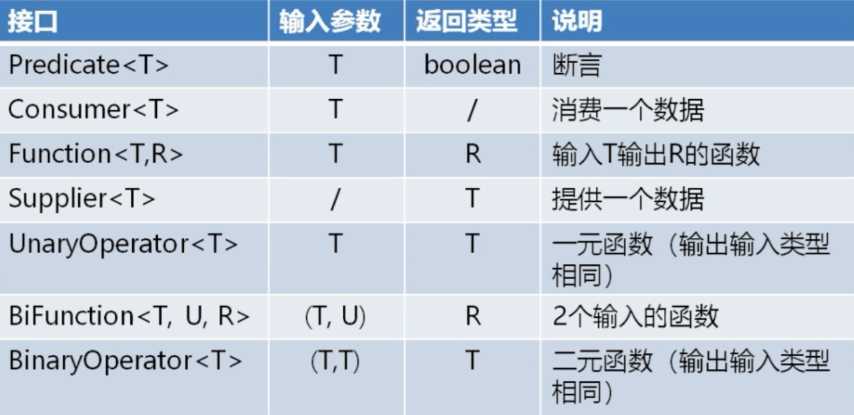标签:obj bsp 体验 param return spl 函数名 tla 阿猫阿狗
在使用lambda表达式和自定义函数接口后,基本已实现java的函数式编程。但是一个自定义函数接口只做一件事,我们在使用的时候只关心需要输入什么参数、用这些参数来做什么,以及返回什么结果;至于接口名称,接口里的函数名称是阿猫阿狗,并不用care。所以直接用一个统一的接口来代替自定义接口,就不用自定义接口了。

Function的使用很简单,只要把上篇的自定义接口改成Function,初体验:
1 public class LambdaTester { 2 public static void main(String[] args) { 3 System.out.println("main function..."); 4 testFunction(); 5 } 6 7 //以函数式接口作为参数 8 //接口Function<T,R>,接收两个范型,T为参数类型,R为返回值类型 9 private String operate2(Integer x, Function<Integer,String> foperation){ 10 return foperation.apply(x); 11 } 12 13 //测试函数接口,用两种方法实现Integer转String 14 public static void testFunction() { 15 LambdaTester tester = new LambdaTester(); 16 17 System.out.println("Integer转String 1:" + tester.operate2(6,x -> x.toString())); 18 System.out.println("Integer转String 2:" + tester.operate2(8,x -> x + "")); 19 20 } 21 }
输出:
main function... Integer转String的方法1:6 Integer转String的方法2:8
Function中定义了四个方法,摘出来瞧瞧:
1 @FunctionalInterface 2 public interface Function<T, R> { 3 4 R apply(T t); //输入T,经apply执行后返回R 5 6 default <V> Function<V, R> compose(Function<? super V, ? extends T> before) { 7 Objects.requireNonNull(before); 8 return (V v) -> apply(before.apply(v)); 9 } 10 11 default <V> Function<T, V> andThen(Function<? super R, ? extends V> after){ 12 Objects.requireNonNull(after); 13 return (T t) -> after.apply(apply(t)); 14 } 15 16 static <T> Function<T, T> identity() { 17 return t -> t; 18 } 19 }
Function中的两个default函数andThen和compose,乍一看不知道干嘛的,都是接收一个Function返回一个Function,函数定义也类似。这种函数的强大之处是可以链式调用,先看andThen的例子:
1 public class LambdaTester { 2 public static void main(String[] args) { 3 System.out.println("main function..."); 4 // testLambda(); 5 // testFunction(); 6 // testDefault(); 7 testAndThen(); 8 } 9 10 //以函数式接口作为参数 11 private String operate3(String x, Function<String,String> foperation){ 12 return foperation.apply(x); 13 } 14 15 public static void testAndThen(){ 16 LambdaTester tester = new LambdaTester(); 17 //函数接口的链式调用 18 Function<String,String> function = x -> x + "world,"; 19 20 //andThen() 21 // @param: Function<? super R, ? extends V> after:接收参数为Function,Function操作的参数是上一个Function执行的结果 22 // @return: <V> Function<T, V>: 返回一个Function 23 System.out.println("结果为:" + tester.operate3("Hello ", 24 function.andThen(s -> s + "I’m java8,") 25 .andThen(s -> s + "enjoy my new feature!"))); 26 } 27 }
输出:
main function... 结果为:Hello world,I’m java8,enjoy my new feature!
来分析下代码执行过程:
第一步:执行operate3,完成字符串拼接,得到结果Hello world,
第二步:将上一步得到的结果Hello world作为andThen()的参数s,执行lambda表达式,得到结果Hello world,I‘m java8,
第三步:将上一步得到的结果Hello world,I‘m java8, 执行lambda表达式,得到结果Hello world,I‘m java8,enjoy my new feature!
这是一种典型的链式调用方法,接收上一步执行的结果,处理后返回一个可以进行链式调用的对象,一级一级处理下去。
其他函数接口和Function类似,可以自行查阅API文档。

只有输出没有输入的是提供者supplier,有输入有输出的是消费者consumer。
标签:obj bsp 体验 param return spl 函数名 tla 阿猫阿狗
原文地址:https://www.cnblogs.com/tangkongkong/p/10385020.html